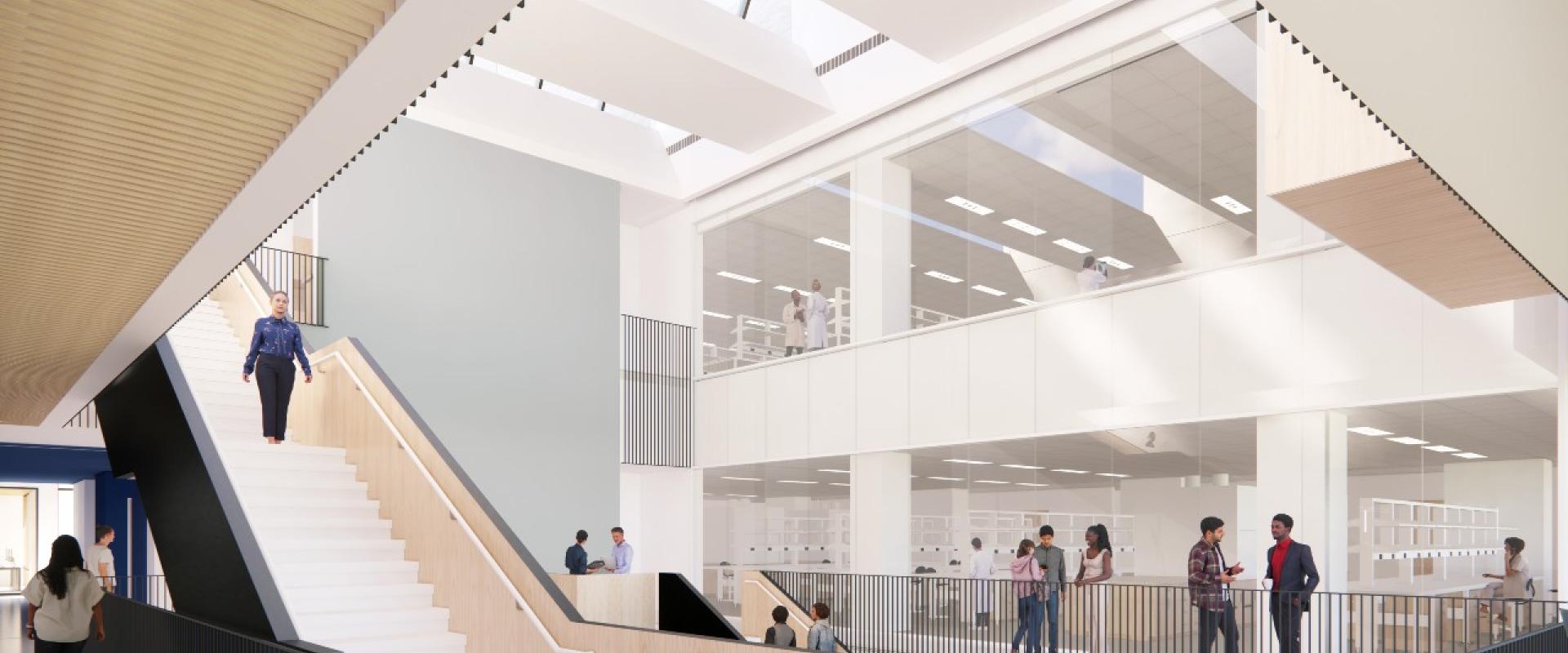Upon opening, Case Western Reserve University’s Interdisciplinary Science and Engineering Building (ISEB) will have one core focus: innovative research. Planned features include wet labs, dry labs, a shared core lab, technology platforms and more, all intended to support hundreds of researchers working together to solve urgent issues facing our world.
The building’s first floor will include an open collaborative space, with the goal of providing a place for people to gather for conversations both casual and research-focused—interactions essential to advancing the university’s mission.
Research Thrusts
Eight unique laboratories are set to call the ISEB home, each representing collaborative approaches to a range of focus areas.
Life Science Therapeutics
From driving pharmaceutical advancements to developing more effective medical diagnostics, researchers in the life sciences are committed to improving people’s quality of life. In the ISEB, researchers from the College of Arts and Sciences and the School of Medicine will work together to accelerate the discovery of new small-molecule therapeutics with an eye to novel intellectual property and collaborative connections.
Precision Diagnostics & Therapeutics
When it comes to assessing human health and disease, a one-size-fits-all approach is impractical. That’s where precision diagnostics and therapeutics come in—approaches designed to factor in individual differences in areas such as genes, environments and lifestyles. Researchers from Case School of Engineering, the College of Arts and Sciences and the School of Medicine will work collaboratively in the ISEB to drive a transdisciplinary approach to these sorts of applications, developing artificial blood, biochips, point-of-need diagnostic platforms and more.
Electrochemistry
Powering society brings daunting challenges—but researchers from Case School of Engineering and the College of Arts and Sciences are working to tackle them. In the ISEB, they’ll drive the development of next-generation energy storage solutions, environmental remediation practices, and novel sustainable electrolytic processes for producing metals and manufacturing semiconductors.
Neuro/Robotics
Imagine worm-like robots that can squeeze into tight spaces to maintain infrastructure, or crab-like robots that can move hazardous debris to aid in surf-zone cleanup. These ideas and others inspired by neurobiology will take shape in the ISEB as researchers—armed with a wind tunnel and a sandbox for testing robots and invertebrates—build on the university’s decades-long strength in adaptive behavior applications.
Sustainable Manufacturing & Materials
Consumer products and energy applications are essential to our society—but creating them in a sustainable way is easier said than done. Researchers from Case School of Engineering and the College of Arts and Science understand this challenge; they’re set to work together in the ISEB, bringing expertise in synthesis, formulation, characterization and processing of nano- to microscale materials in ways to revolutionize everyday applications.
Climate & Ecosystems
There’s no denying our planet’s organisms and ecosystems are changing. In the ISEB, researchers will integrate field observations, lab experiments and modeling to understand the drivers, mechanisms, limits and consequences of biological responses to this change. Study sites range from Ohio to the Arctic, land to ocean, and the geological past to modern-day Earth.
AI Applications
As artificial intelligence continues to shape the world in which we live, researchers are poised to harness its potential. In the ISEB, they’ll apply machine learning to predictive and prognostic modeling for disease outcomes, paving the way for AI-informed medical decision-making across patient and population interfaces. These efforts are poised to usher in the next generation of precision therapeutics, enhancing outcomes for patients who can receive individualized treatments.
Neurotechnology
In the ISEB, neurotechnology researchers will focus on the discovery, translation, and commercialization of solutions to neurological conditions that affect millions—such as strokes, spinal cord injuries, chronic pain, movement disorders, and cognitive decline. Through interdisciplinary and intersectoral collaboration, researchers will develop technologies that interface with the brain, spinal cord, and peripheral nervous system using electrical and optical stimulation, focused ultrasound, neural recording, and physiological sensing. By integrating computational modeling, signal processing, and artificial intelligence, teams can accelerate the development of clinically effective and commercially viable solutions that help people regain function, restore independence, and improve quality of life.


